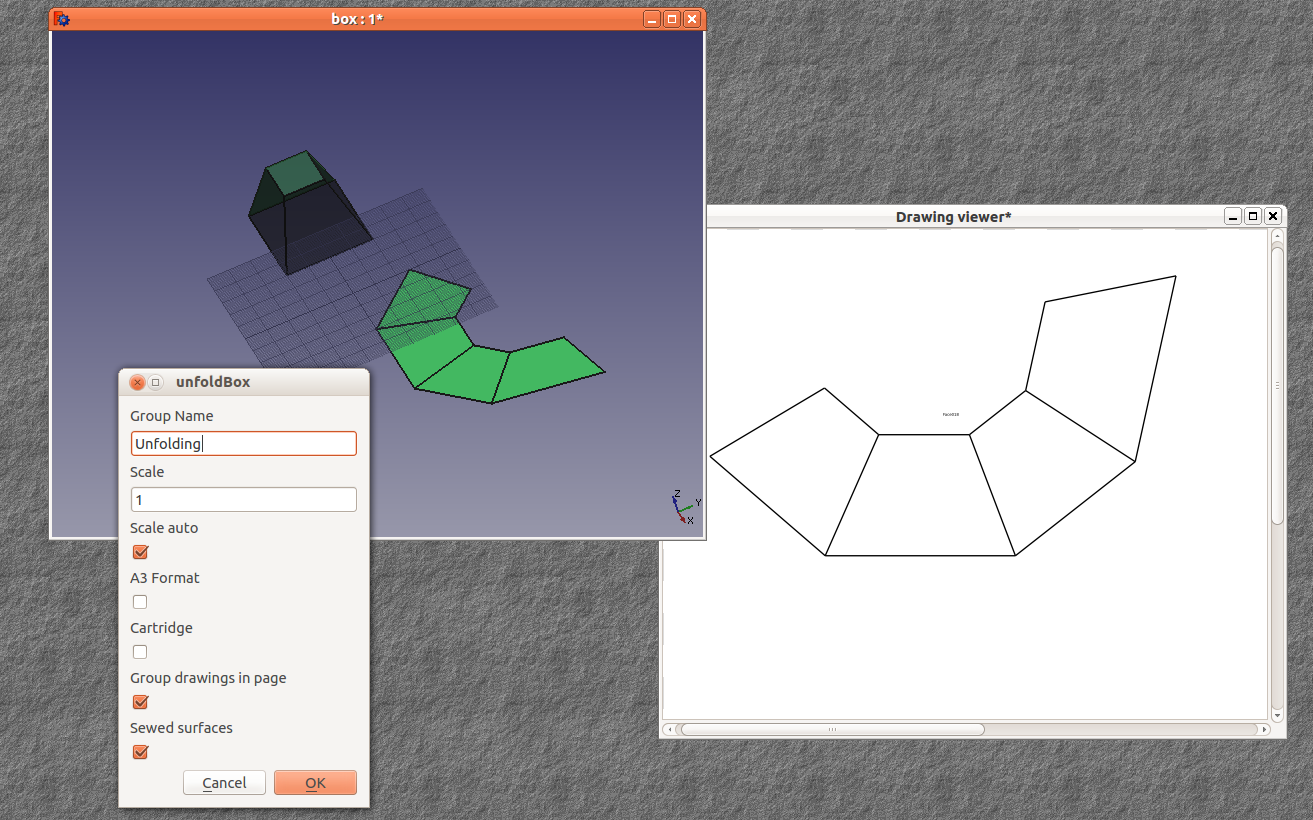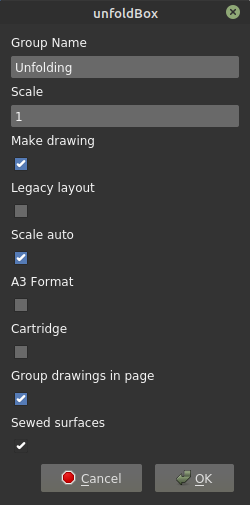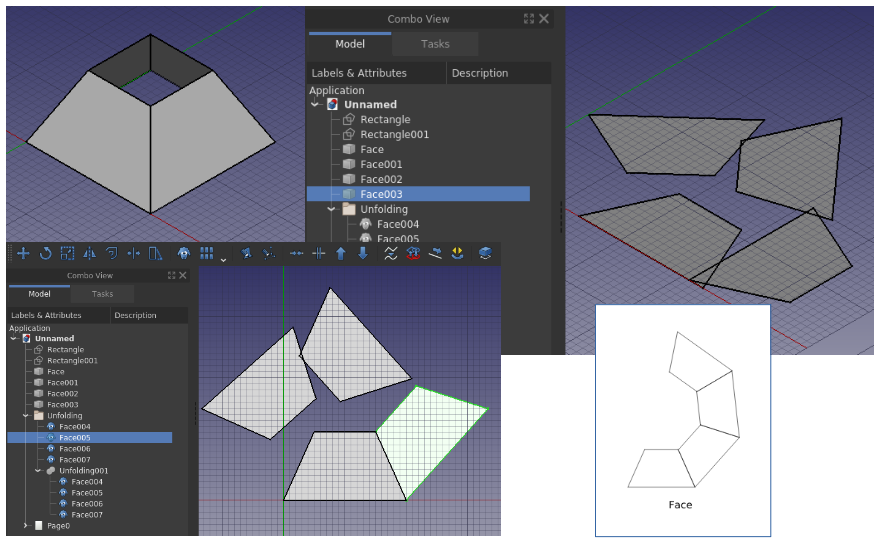Macro Unfold Box/ko
| Description |
|---|
| 이 매크로를 이용하면 어떤 모양의 상자든지 표면을 펼쳐서 평면에 그릴 수 있습니다. Macro version: 1.1 Last modified: 2022-07-28 Download: ToolBar Icon Author: Hervé B., heda |
| Author |
| Hervé B., heda |
| Download |
| ToolBar Icon |
| Links |
| Macros recipes How to install macros How to customize toolbars |
| Macro Version |
| 1.1 |
| Date last modified |
| 2022-07-28 |
| FreeCAD Version(s) |
| Default shortcut |
| None |
| See also |
| None |
설명
이 매크로를 이용하면 어떤 모양의 상자든지 표면을 펼쳐서 평면에 그릴 수 있습니다.
Unfold Box 매크로
설치
애드온 관리자 에서 설치할 수 있습니다.
토론장 주제: Macro for unfolding box surfaces.
선택 사항
- 수동 또는 자동으로 배율(Scale) 조정.
- 페이지 형식: A4/A3, 카트리지(FreeCAD 템플릿 참조).
- 가능할 경우 같은 페이지에 도면들을 모둠
용법
- 예를 들어 부품 작업대의 로프트 도구로 만든 상자를 선택하세요.
- 분할된 면으로 도면 다운그레이드를 합니다.
- 분할된 면들을 선택합니다.
- 매크로를 실행합니다.
펼침 알고리즘은 면을 XY 평면에 배치하지만, 펼침을 올바르게 수행하는 경우는 드뭅니다. 따라서 아래 그림에서 보듯이 원하는 결과를 얻으려면 수동으로 일부 후처리 작업이 필요합니다.
시작점은 왼쪽 위 그림과 같은 상자입니다.
- 모든 면을 선택하고 매크로를 실행합니다.
- 윗면 보기로 방향을 조정합니다.
- 생성된 면들의 가시성을 전환합니다. 합성물이 아닌 개별 복제본이 표시됩니다.
- 도면 이동과 도면 회전을 사용하여 펼쳐진 복제된 면을 다시 배치합니다(포착기능을 사용할 경우 면당 몇 번의 클릭).
- 도면은 자동으로 새로운 위치로 자리잡게 됩니다.
완성된 결과는 위의 오른쪽 아래 그림에 나와 있습니다.
스크립트
Macro_unfoldBox.FCMacro
# -*- coding: utf-8 -*-
"""
FreeCAD Macro unfoldBox.
Unfolding of planar surfaces
"""
##################################################
# SEE https://wiki.freecad.org/Macro_Unfold_Box
# ***************************************************************************
# * *
# * Copyright (c) 2013 - DoNovae/Herve BAILLY <hbl13@donovae.com> *
# * Copyright (c) 2022 - heda <heda@fc-forum> *
# * *
# * This program is free software; you can redistribute it and/or modify *
# * it under the terms of the GNU Lesser General Public License (LGPL) *
# * as published by the Free Software Foundation; either version 2 of *
# * the License, or (at your option) any later version. *
# * for detail see the LICENCE text file. *
# * *
# * This program is distributed in the hope that it will be useful, *
# * but WITHOUT ANY WARRANTY; without even the implied warranty of *
# * MERCHANTABILITY or FITNESS FOR A PARTICULAR PURPOSE. See the *
# * GNU Library General Public License for more details. *
# * *
# * You should have received a copy of the GNU Library General Public *
# * License along with this program; if not, write to the Free Software *
# * Foundation, Inc., 59 Temple Place, Suite 330, Boston, MA 02111-1307 *
# * USA *
# * *
# ***************************************************************************
__Name__ = 'Unfold Box'
__Comment__ = 'Unfolds planar surfaces and draws them on a page.'
__Author__ = 'Hervé B., heda'
__Version__ = '1.1'
__Date__ = '2022-07-28'
__License__ = 'LGPL-2.0-or-later'
__Web__ = 'https://wiki.freecad.org/Macro_Unfold_Box'
__Wiki__ = 'https://wiki.freecad.org/Macro_Unfold_Box'
__Icon__ = ''
__Help__ = ('Select surfaces, Explode them (cf Draft menu Downgrade), '
'Select the exploded surfaces, Execute the macro')
__Status__ = ''
__Requires__ = ''
__Communication__ = ''
__Files__ = ''
__doc__ = """
select a face, or several and run the macro.
a shell/solid needs to be draft/downgraded to get the faces as separate objects
the macro is intended to unfold a set of planar faces,
in current state, most of the times it does not place the faces correctly.
thus one needs to do the final placement of the clones manually, with Draft/Move & Rotate
regardless, the macro saves a lot of clicks compared to a fully manual unfold
settings are not context aware, all settings not applicable are ignored.
as example, using autoscaling ignores the scale-value in the form
sew is always enabled, thus the drawing
is always the sewed shape on a single page
v1.1 (2022-07-28) py3/qt5 compat, cosmetic code changes,
minor code tweaks for evolved fc-api
added option to skip drawing, made layout engine with techdraw,
the drawing wb layout engine is now called "legacy"
v1.0.1 (2020-03-10) - on wiki
v1.0 (2013-09-14) - on wiki
note:
- unfolding occasionally work as expected, but mostly not
- anyone is free to improve functionality
"""
import os, math
from PySide import QtGui, QtCore
import FreeCAD, FreeCADGui
import Draft
Vector = FreeCAD.Base.Vector
Units = FreeCAD.Units
PrintMessage = FreeCAD.Console.PrintMessage
PrintError = FreeCAD.Console.PrintError
fields_l = []
unroll_l = []
dwgtpllegacy = 'Mod/Drawing/Templates'
dwgtpl = 'Mod/TechDraw/Templates'
#####################################
### Functions
#####################################
def errorDialog(msg):
diag = QtGui.QMessageBox(QtGui.QMessageBox.Critical, 'Error Message', msg)
diag.setWindowFlags(QtCore.Qt.WindowStaysOnTopHint)
diag.exec_()
def proceed():
QtGui.QApplication.setOverrideCursor(QtCore.Qt.WaitCursor)
PrintMessage('===========================================\n')
PrintMessage('unfoldBox: start.\n')
try:
file_name = fields_l[0].text()
makedwg = makedwg_check.isChecked()
leglay = leglay_check.isChecked()
scale = float(fields_l[1].text())
scale_auto = scale_check.isChecked()
a3 = a3_check.isChecked()
cartridge = cartridge_check.isChecked()
onedrawing = onedrawing_check.isChecked()
sewed = sewed_check.isChecked()
PrintMessage('unfoldBox.file_name: {}\n'.format(file_name))
PrintMessage('unfoldBox.makedwg: {}\n'.format(makedwg))
PrintMessage('unfoldBox.leglay: {}\n'.format(leglay))
PrintMessage('unfoldBox.scale: {}\n'.format(scale))
PrintMessage('unfoldBox.scale_check: {}\n'.format(scale_auto))
PrintMessage('unfoldBox.a3_check: {}\n'.format(a3))
PrintMessage('unfoldBox.cartridge: {}\n'.format(cartridge))
PrintMessage('unfoldBox.onedrawing: {}\n'.format(onedrawing))
PrintMessage('unfoldBox.sewed: {}\n'.format(sewed))
except:
msg = 'unfoldBox: wrong inputs...\n'
PrintError(msg)
errorDialog(msg)
QtGui.QApplication.restoreOverrideCursor()
DialogBox.hide()
## Get selection
sel = FreeCADGui.Selection.getSelection()
if not sel or len(sel) < 2:
PrintMessage('unfoldBox: requires at least 2 selected faces, ending.\n')
return
doc = FreeCAD.ActiveDocument
objnames_l=[]
grp = doc.addObject('App::DocumentObjectGroup', str(file_name))
for objid in range(len(sel)):
obj = Draft.make_clone(sel[objid])
grp.addObject(obj)
objnames_l.append([ obj, sel[objid].Name ])
doc.recompute()
unfold = unfoldBox(doc)
if sewed:
objnames_l = unfold.done(objnames_l)
grp.addObject(objnames_l[0][0])
else:
for objid in range(len(objnames_l)):
unfold.moveXY(objnames_l[objid][0])
if not makedwg:
return
if leglay:
idx = 0
while len(objnames_l) > 0:
draw = Drawing2dLegacy(scale, scale_auto, a3,
cartridge, onedrawing,
doc.Name, 'Page'+str(idx))
objnames_l = draw.all_(objnames_l)
idx += 1
PrintMessage('unfoldBox: obj_l= {}\n'.format(len(objnames_l)))
else:
draw = Drawing2d(scale, scale_auto, a3, cartridge)
draw.drawpage(objnames_l[0], "{}Page".format(file_name))
PrintMessage('unfoldBox: end.\n')
PrintMessage('===========================================\n')
def close():
DialogBox.hide()
def getType(obj):
return type(obj).__name__
def mkmm(l):
return Units.Quantity(l, Units.Length)
class unfoldBox:
def __init__(self, doc):
PrintMessage('unfoldBox.unfoldBox\n')
self.doc = doc
self.LIMIT = 0.0001
def done(self, objnames_l):
tree_l = self.makeTree(objnames_l)
for idx in range(len(objnames_l)):
face = objnames_l[idx]
self.moveXY(face[0])
self.sew(objnames_l, tree_l)
return self.fusion(objnames_l)
def getEndPoints(self, edge):
return [v.Point for v in edge.Vertexes]
def makeTree(self, objnames_l):
## Initialisation of tree_l.
tree_l = []
for k in range(len(objnames_l)):
facek = objnames_l[k][0]
facekEdges = facek.Shape.Edges
facek_l = []
for i in range(len(facekEdges)):
if False and getType(facekEdges[i].Curve) != 'GeomLineSegment':
## this is a no-op...
facek_l.append([-1, -1])
else:
## Search face link to the ith edge
#vki0 = facekEdges[i].Curve.StartPoint
#vki1 = facekEdges[i].Curve.EndPoint
vki0, vki1 = self.getEndPoints(facekEdges[i])
found = False
for l in range(k+1, len(objnames_l)):
facel = objnames_l[l][0]
facelEdges = facel.Shape.Edges
for j in range(len(facelEdges)):
#vlj0 = facelEdges[j].Curve.StartPoint
#vlj1 = facelEdges[j].Curve.EndPoint
vlj0, vlj1 = self.getEndPoints(facelEdges[j])
if (vki0.isEqual(vlj0, self.LIMIT)
and vki1.isEqual(vlj1, self.LIMIT)):
arelinked = False
isfacek = isfacel = False
for kk in range(k-1):
for ii in range(len(tree_l[kk])):
isfacek = tree_l[kk][ii][0] == k
isfacel = tree_l[kk][ii][0] == l
if isfacek and isfacel:
arelinked = True
break
if not arelinked:
facek_l.append([l, j])
found = True
break
if found:
break
if not found:
facek_l.append([-1, -1])
tree_l.append(facek_l)
return tree_l
def sew(self, objnames_l, tree_l):
placed_l = []
for k in range(len(tree_l)):
iskplaced = False
for p in range(len(placed_l)):
iskplaced = placed_l[p] == k
if not iskplaced:
placed_l.append(k)
facek = tree_l[k]
objk = objnames_l[k][0]
for i in range(len(facek)):
edgeki = facek[i]
l, j = edgeki[:2]
islplaced = False
for p in range(len(placed_l)):
if placed_l[p] == l:
islplaced = True
break
if not islplaced:
placed_l.append(l)
if l >= 0 and not (islplaced and iskplaced):
iskplaced = True
## Move facel.edgelj to facek.edgeki.
objl = objnames_l[l][0]
#vki0 = objk.Shape.Edges[i].Curve.StartPoint
#vki1 = objk.Shape.Edges[i].Curve.EndPoint
vki0, vki1 = self.getEndPoints(objk.Shape.Edges[i])
#vlj0 = objl.Shape.Edges[j].Curve.StartPoint
#vlj1 = objl.Shape.Edges[j].Curve.EndPoint
vlj0, vlj1 = self.getEndPoints(objk.Shape.Edges[j])
vk = vki1.sub(vki0)
vl = vlj1.sub(vlj0)
alpk = vk.getAngle(vl) * 180 / math.pi
alpl = vl.getAngle(vk) * 180 / math.pi
self.isPlanZ(objk)
if islplaced:
Draft.move(objk, vlj0.sub(vki0))
else:
Draft.move(objl, vki0.sub(vlj0))
self.isPlanZ(objk)
if math.fabs(vk.dot(Vector(-vl.y, vl.x, 0))) > self.LIMIT:
if islplaced:
Draft.rotate(objk, -alpl, vlj0, self.vecto(vl, vk))
else:
Draft.rotate(objl, -alpk, vki0, self.vecto(vk, vl))
elif vk.dot(vl) < 0:
if islplaced:
Draft.rotate(objk, 180, vlj0, self.vecto(vl, Vector(-vl.y, vl.x, 0)))
else:
Draft.rotate(objl, 180, vki0, self.vecto(vk, Vector(-vk.y, vk.x, 0)))
## Verifications.
#vki0 = objk.Shape.Edges[i].Curve.StartPoint
#vki1 = objk.Shape.Edges[i].Curve.EndPoint
vki0, vki1 = self.getEndPoints(objk.Shape.Edges[i])
#vlj0 = objl.Shape.Edges[j].Curve.StartPoint
#vlj1 = objl.Shape.Edges[j].Curve.EndPoint
vli0, vli1 = self.getEndPoints(objk.Shape.Edges[j])
vk = vki1.sub(vki0)
vl = vlj1.sub(vlj0)
self.isPlanZ(objk)
## Flip or not.
bbl, bbk = objl.Shape.BoundBox, objk.Shape.BoundBox
L = max(bbl.XMax, bbk.XMax) - min(bbl.XMin, bbk.XMin)
W = max(bbl.YMax, bbk.YMax) - min(bbl.YMin, bbk.YMin)
S1 = L * W
if islplaced:
Draft.rotate(objk, 180, vlj0, vl)
else:
Draft.rotate(objl, 180, vki0, vk)
bbl, bbk = objl.Shape.BoundBox, objk.Shape.BoundBox
L = max(bbl.XMax, bbk.XMax) - min(bbl.XMin, bbk.XMin)
W = max(bbl.YMax, bbk.YMax) - min(bbl.YMin, bbk.YMin)
S2 = L * W
if S2 <= S1:
if islplaced:
Draft.rotate(objk, 180, vlj0, vl)
else:
Draft.rotate(objl, 180, vki0, vk)
self.isPlanZ(objk)
def isPlanZ(self, obj):
bb = obj.Shape.BoundBox
L = bb.XMax - bb.XMin
W = bb.YMax - bb.YMin
H = bb.ZMax - bb.ZMin
return H < self.LIMIT
def fusion(self, objnames_l):
## Init.
obj_l, objna_l =[], []
obj0, name = objnames_l[0]
objfuse = self.doc.addObject('Part::MultiFuse', 'Unfolding')
for k in range(len(objnames_l)):
objk = objnames_l[k][0]
obj_l.append(objk)
objfuse.Shapes = obj_l
self.doc.recompute()
objna_l.append([objfuse, name])
return objna_l
def get2Vectors(self, shape):
"""not used in v1.1"""
v0, v1 = Vector(), Vector()
edges = shape.Edges
for idx in range(len(edges) - 1):
e1, e2 = edges[idx], edges[idx + 1]
## .EndPoint errors out...
va = e1.Curve.EndPoint.sub(e1.Curve.StartPoint)
vb = e2.Curve.EndPoint.sub(e2.Curve.StartPoint)
if vb.sub(va).Length > v1.sub(v0).Length:
v0, v1 = self.vect_copy(va), self.vect_copy(vb)
return [v0, v1]
def vecto(self, vect1, vect2):
'''Function vecto.'''
v = Vector()
v.x = vect1.y * vect2.z - vect1.z * vect2.y
v.y = vect1.z * vect2.x - vect1.x * vect2.z
v.z = vect1.x * vect2.y - vect1.y * vect2.x
return v
def vect_copy(self, vect):
'''Return a copy of vector.'''
return vect.add(Vector())
def moveXY(self, obj):
## Move to origin
bb = obj.Shape.BoundBox
Draft.move(obj, Vector(-bb.XMin, -bb.YMin, -bb.ZMin))
## Find 2 vectors defining the plan of surface
#tab = self.get2Vectors(obj.Shape)
#v0, v1 = tab[:2]
#norm = self.vecto(v0, v1)
#norm.normalize()
## above gives null vector, and errors out...
## probably sprung out of some api-change over time
## probably part.line vs part.linesegment...
## a part.line does not have edge.Curve.StartPoint, or .EndPoint any more
## the semantics is to get first & second point from a line,
## so edge.Curve.value(edge.Curve.FirstParameter) should get the sought values
## however easier to just use edge.Vertexes...
## which appears to have same orientation
norm = obj.Shape.findPlane().Axis ## works for planar surfaces
#norm = obj.Shape.Surface.Axis ## gives worse results...
norm.normalize()
## Rotate.
nx, ny, nz = (math.fabs(xyz) for xyz in norm)
if nx < self.LIMIT and nz < self.LIMIT:
Draft.rotate(obj, 90, Vector(0, 0, 0), Vector(1, 0, 0))
elif ny < self.LIMIT and nz < self.LIMIT:
Draft.rotate(obj, 90, Vector(0, 0, 0), Vector(0, 1, 0))
else:
## Rotate following the angle to the normal direction of the plan.
oz = Vector(0, 0, 1)
alp = oz.getAngle(norm) * 180 / math.pi
vecto = self.vecto(oz, norm)
rotv = oz if vecto.isEqual(Vector(), self.LIMIT) else self.vecto(oz, norm)
#rotv = norm if vecto.isEqual(Vector(), self.LIMIT) else self.vecto(oz, norm)
## flipping here seems to give worse results as well...
Draft.rotate(obj, -alp, Vector(0, 0, 0), rotv)
## Move to z = 0.
Draft.move(obj, Vector(0, 0, -obj.Shape.BoundBox.ZMin))
class Scale:
"""keeps autoscaling to integers"""
def __init__(self, scale):
self.scale = scale if scale >= 1 else 1 / scale
self.scale = int(self.scale)
self.inverted = scale >= 1
def get(self):
if self.inverted:
return self.scale, '{}:1'.format(self.scale)
else:
return 1/self.scale, '1:{}'.format(self.scale)
class Drawing2d:
def __init__(self, scale, scale_auto, a3, cartridge):
"""techdraw based layout for one page only"""
self.scale = scale
self.scale_auto = scale_auto
self.a3 = a3
self.cartridge = cartridge
if a3:
self.WH = 420, 297
else:
self.WH = 297, 210
self.doc = FreeCAD.ActiveDocument
def newPage(self, page_name):
freecad_dir = os.path.join(FreeCAD.getResourceDir(), dwgtpl)
page = self.doc.addObject('TechDraw::DrawPage', page_name)
template = self.doc.addObject('TechDraw::DrawSVGTemplate', 'Template')
size = 'A3' if self.a3 else 'A4'
frame = 'TD' if self.cartridge else '_blank'
template.Template = freecad_dir + '/{}_Landscape{}.svg'.format(size, frame)
page.Template = template
return page
def drawpage(self, objname, page_name):
page = self.newPage(page_name)
faceset, name = objname
bb = faceset.Shape.BoundBox
## bb does not auto-update, have to pick up new bb after manipulation
if bb.YLength > bb.XLength: ## auto rotate
Draft.rotate(faceset, 90)
bb = faceset.Shape.BoundBox
Draft.move(faceset, Vector(-bb.XMin, -bb.YMin, 0))
bb = faceset.Shape.BoundBox
W, H = self.WH
xr, yr = W / bb.XLength, H / bb.YLength
adjust = 0.7 if self.cartridge else 0.85
scale = min(xr, yr) * adjust if self.scale_auto else self.scale
scale, scr = Scale(scale).get()
bb.scale(scale, scale, 1) ## faceset in xy-plane
TopView = self.doc.addObject('TechDraw::DrawViewPart', 'TopView')
page.addView(TopView)
TopView.Source = faceset
TopView.Direction = (0, 0, 1)
TopView.XDirection = (1, 0, 0)
TopView.Scale = scale
Text = self.doc.addObject('TechDraw::DrawViewAnnotation', name)
page.addView(Text)
Text.Text = name
Text.recompute() # for size
bb.scale(scale, scale, scale)
yt = (H - bb.YLength) / 2 - Text.TextSize.Value * 1.5
Text.Y = max(1, yt)
self.doc.recompute()
page.ViewObject.doubleClicked()
FreeCADGui.runCommand('TechDraw_ToggleFrame', 0)
class Drawing2dLegacy:
def __init__(self, scale, scale_auto, a3, cartridge, onedrawing,
drawing_name, page_name):
"""Function __init__
- scale
- scale_auto
- a3
- cartridge
- onedrawing
v1.1 - renamed to legacy, functional wise untouched
"""
self.TopX_H = self.TopY_H = 0
self.TopX_V = self.TopY_V = 0
self.TopX_Hmax = self.TopY_Hmax = 0
self.TopX_Vmax = self.TopY_Vmax = 0
self.a3 = a3
self.scale = scale
self.scale_auto = scale_auto
self.cartridge = cartridge
self.onedrawing = onedrawing
self.marge = 6
if self.a3:
self.L, self.H = 420, 297
else:
self.L, self.H = 297, 210
self.page_name = page_name
self.drawing_name = drawing_name
self.doc = FreeCAD.ActiveDocument
def newPage(self):
freecad_dir = os.path.join(FreeCAD.getResourceDir(), dwgtpllegacy)
page = self.doc.addObject('Drawing::FeaturePage', self.page_name)
size = 'A3' if self.a3 else 'A4'
frame = '' if self.cartridge else '_plain'
page.Template = freecad_dir + '/{}_Landscape{}.svg'.format(size, frame)
return page
def all_(self, objnames_l):
obj_l = []
for objid in range(len(objnames_l)):
if objid == 0 or not self.onedrawing:
self.newPage()
obj_l.extend(self.done(objid, objnames_l[objid]))
return obj_l
def done(self, id_, objname):
## Init.
obj_l = []
obj, objname = objname
bb = obj.Shape.BoundBox
xmax, ymax = bb.XMax - bb.XMin, bb.YMax - bb.YMin
if ymax > xmax:
Draft.rotate(obj, 90)
bb = obj.Shape.BoundBox
Draft.move(obj, Vector(-bb.XMin, -bb.YMin, 0))
bb = obj.Shape.BoundBox ## does not auto-update, have to pick up new obj
xmax = bb.XMax - bb.XMin
ymax = bb.YMax - bb.YMin
scale = min((self.L-4*self.marge) / xmax, (self.H-4*self.marge) / ymax)
if (not self.scale_auto) or (self.onedrawing):
scale = self.scale
if id_ == 0 or not self.onedrawing:
## Init.
PrintMessage('Drawing2d: init\n')
self.TopX_H = self.TopY_H = self.marge * 2
TopX, TopY = self.TopX_H, self.TopY_H
self.TopX_H = self.TopX_H + xmax * scale + self.marge
self.TopY_H = self.TopY_H
self.TopX_Hmax = max(self.TopX_Hmax, self.TopX_H)
self.TopY_Hmax = max(self.TopY_Hmax,
self.TopY_H + ymax*scale + self.marge)
self.TopX_Vmax = max(self.TopX_Vmax, self.TopX_Hmax)
self.TopX_V = max(self.TopX_Vmax, self.TopX_V)
self.TopY_V = self.marge * 2
elif self.onedrawing:
if self.TopX_H + xmax * scale < self.L:
if self.TopY_H + ymax * scale + self.marge*2 < self.H:
## H Add at right on same horizontal line.
PrintMessage('Drawing2d: horizontal\n')
TopX, TopY = self.TopX_H, self.TopY_H
self.TopX_H = self.TopX_H + xmax * scale + self.marge
self.TopX_Hmax = max(self.TopX_Hmax, self.TopX_H)
self.TopY_Hmax = max(self.TopY_Hmax,
self.TopY_H + ymax*scale + self.marge)
self.TopX_Vmax = max(self.TopX_Hmax, self.TopX_Vmax)
self.TopX_Vmax = max(self.TopX_Vmax, self.TopX_Hmax)
self.TopX_V = max(self.TopX_Vmax, self.TopX_V)
else:
## V Add at right on same horizontal line
PrintMessage('Drawing2d: vertival\n')
if (self.TopX_V + ymax * scale + 2 * self.marge < self.L
and self.TopY_V + xmax * scale + 2*self.marge < self.H):
Draft.rotate(obj, 90)
bb = obj.Shape.BoundBox
Draft.move(obj, Vector(-bb.XMin, -bb.YMin, 0))
self.TopX_V = max(self.TopX_Vmax, self.TopX_V)
TopX, TopY = self.TopX_V, self.TopY_V
self.TopX_V = self.TopX_V + ymax * scale + self.marge
self.TopY_Vmax = max(self.TopY_Vmax,
self.TopY_V + xmax * scale + self.marge)
else:
obj_l.append([obj, 'name'])
return obj_l
else:
## H Carriage return.
if (self.TopY_Hmax + ymax * scale + self.marge*2 < self.H):
msg = 'Drawing2d: carriage return: {} > {}\n'
PrintMessage(msg.format(self.TopY_H + ymax * scale, self.H))
TopX = self.marge*2
TopY = self.TopY_Hmax
self.TopX_H = TopX + xmax * scale + self.marge
self.TopY_H = TopY
self.TopX_Hmax = max(self.TopX_Hmax, self.TopX_H)
self.TopY_Hmax = self.TopY_Hmax + ymax*scale+self.marge
self.TopX_Vmax = max(self.TopX_Vmax, self.TopX_Hmax)
self.TopX_V = max(self.TopX_Vmax, self.TopX_V)
else:
## V Add at right on same horizontal line.
msg = 'Drawing2d: vertical: {}, {}\n'
PrintMessage(msg.format(self.TopX_V, self.TopX_Vmax))
if (self.TopX_V + ymax * scale + 2*self.marge < self.L
and self.TopY_V + xmax * scale + 2*self.marge < self.H):
Draft.rotate(obj, 90)
bb = obj.Shape.BoundBox
Draft.move(obj, Vector(-bb.XMin, -bb.YMin, 0))
TopX, TopY = self.TopX_V, self.TopY_V
self.TopX_V = self.TopX_V + ymax * scale + self.marge
self.TopY_Vmax = max(self.TopY_Vmax,
self.TopY_V + xmax * scale + self.marge)
else:
obj_l.append([obj, 'name'])
return obj_l
page = self.doc.getObject(self.page_name)
## Drawing wb (untouched)
Text = self.doc.addObject('Drawing::FeatureViewAnnotation', objname + '_txt')
Text.Text = objname
Text.X = TopX + xmax / 2 * scale
Text.Y = TopY + ymax / 2 * scale
Text.Scale = 7 if self.a3 else 5
TopView = self.doc.addObject('Drawing::FeatureViewPart', 'TopView')
TopView.Source = obj
TopView.Direction = (0.0, 0.0, 1)
TopView.Rotation = 0
TopView.X = TopX
TopView.Y = TopY
TopView.ShowHiddenLines = True
TopView.Scale = scale
page.addObject(TopView)
page.addObject(Text)
self.doc.recompute()
page.ViewObject.doubleClicked()
return obj_l
#####################################
### Dialog Box
#####################################
fields = [['Group Name', 'Unfolding']]
fields.append(['Scale', '1'])
DialogBox = QtGui.QDialog()
DialogBox.resize(250, 250)
DialogBox.setWindowTitle('unfoldBox')
la = QtGui.QVBoxLayout(DialogBox)
# Input fields.
for id_ in range(len(fields)):
la.addWidget(QtGui.QLabel(fields[id_][0]))
fields_l.append(QtGui.QLineEdit(fields[id_][1]))
la.addWidget(fields_l[id_])
makedwg_check = QtGui.QCheckBox(DialogBox)
makedwg_check.setObjectName('checkBox')
makedwg_check.setChecked(True)
la.addWidget(QtGui.QLabel('Make drawing'))
la.addWidget(makedwg_check)
leglay_check = QtGui.QCheckBox(DialogBox)
leglay_check.setObjectName('checkBox')
leglay_check.setChecked(False)
la.addWidget(QtGui.QLabel('Legacy layout'))
la.addWidget(leglay_check)
scale_check = QtGui.QCheckBox(DialogBox)
scale_check.setObjectName('checkBox')
scale_check.setChecked(True)
la.addWidget(QtGui.QLabel('Scale auto'))
la.addWidget(scale_check)
a3_check = QtGui.QCheckBox(DialogBox)
a3_check.setObjectName('checkBox')
la.addWidget(QtGui.QLabel('A3 Format'))
a3_check.setChecked(False)
la.addWidget(a3_check)
cartridge_check = QtGui.QCheckBox(DialogBox)
cartridge_check.setObjectName('checkBox')
la.addWidget(QtGui.QLabel('Cartridge'))
cartridge_check.setChecked(False)
la.addWidget(cartridge_check)
onedrawing_check = QtGui.QCheckBox(DialogBox)
onedrawing_check.setObjectName('checkBox')
la.addWidget(QtGui.QLabel('Group drawings in page'))
onedrawing_check.setChecked(True)
la.addWidget(onedrawing_check)
sewed_check = QtGui.QCheckBox(DialogBox)
sewed_check.setObjectName('checkBox')
la.addWidget(QtGui.QLabel('Sewed surfaces'))
sewed_check.setChecked(True)
sewed_check.setEnabled(False)
la.addWidget(sewed_check)
box = QtGui.QDialogButtonBox(DialogBox)
box = QtGui.QDialogButtonBox(DialogBox)
box.setOrientation(QtCore.Qt.Horizontal)
box.setStandardButtons(QtGui.QDialogButtonBox.Cancel | QtGui.QDialogButtonBox.Ok)
la.addWidget(box)
QtCore.QObject.connect(box, QtCore.SIGNAL('accepted()'), proceed)
QtCore.QObject.connect(box, QtCore.SIGNAL('rejected()'), close)
QtCore.QMetaObject.connectSlotsByName(DialogBox)
DialogBox.show()



